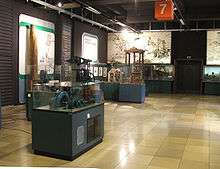German Mining Museum
The German Mining Museum in Bochum (German: Deutsches Bergbau-Museum Bochum) or DBM is one of the most visited museums in Germany with around 365,700 visitors per year (2012).[1] It is the largest mining museum in the world,[2] and a renowned research establishment for mining history.
.jpg) The German Mining Museum in Bochum | |

| |
| Established | 1930 |
|---|---|
| Location | Bochum, North Rhine-Westphalia |
| Coordinates | 51°29′21″N 7°13′2″E |
| Type | Museum, research establishment Humanities, Natural Sciences, History, Engineering |
| Accreditation | Leibniz-Gemeinschaft |
| Curator | Stefan Brüggerhoff |
| Owner | DMT-Gesellschaft für Lehre und Bildung mbH, and the city of Bochum |
| Employees | ca. 140[1] |
| Website | www.BergbauMuseum.de |

Above-ground exhibitions, and a faithfully reconstructed show mine below the museum terrain give visitors insights into the world of mining. The main areas of research by the scientists are the History and Technology of Mining (Geschichte und Technik des Montanwesens), and the Documentation and Conservation of Cultural Artefacts (Dokumentation und Schutz von Kulturgut). As a research institute, the museum is a member of the Gottfried Wilhelm Leibniz Scientific Community.
Literature
- Olaf Hartung: Museen des Industrialismus: Formen bürgerlicher Geschichtskultur am Beispiel des Bayerischen Verkehrsmuseums und des Deutschen Bergbaumuseums. Cologne [et al.] 2007 (Beiträge zur Geschichtskultur; Bd. 32), Also: Kiel, Univ., Diss., 2007, ISBN 978-3-412-13506-5.
- Rainer Slotta (ed.): 75 Jahre Deutsches Bergbau-Museum Bochum (1930 bis 2005). Vom Wachsen und Werden eines Museums. 2 vols., Bochum, 2005, ISBN 3-937203-15-X
- Evelyn Kroker: Das Bergbau-Archiv Bochum und seine Bestände. Bochum, 2001.
See also
References
- Auskunft der Pressestelle des DBM, 12 September 2013
- DBM (retrieved 12 September 2013)
External links
| Wikimedia Commons has media related to Bergbaumuseum Bochum. |
- www.BergbauMuseum.de — website of the German Mining Museum, Bochum
- VFKK.de — Vereinigung der Freunde von Kunst und Kultur im Bergbau e.V., Bochum (in German)
- Schätze der Anden - Chiles Kupfer für die Welt (8 May 2011 to 19 February 2012) (in German)
- Description of this anchor point as part of the Route of Industrial Culture
- Deutsches Bergbaumuseum – Geschenkt: Das kleine Schwarze, RuhrNachrichten.de, 13 January 2011, Ronny von Wangenheim (in German)